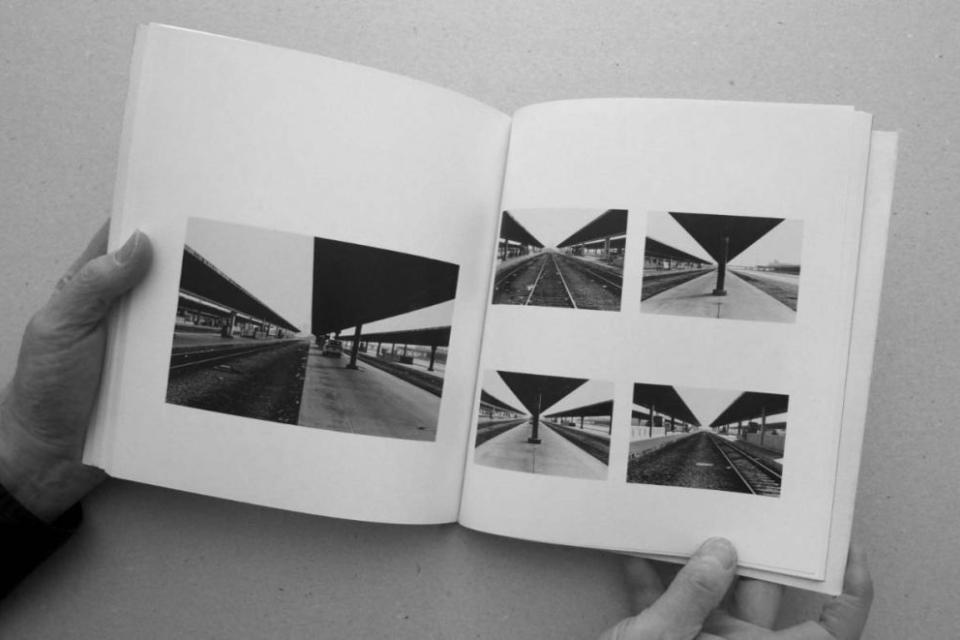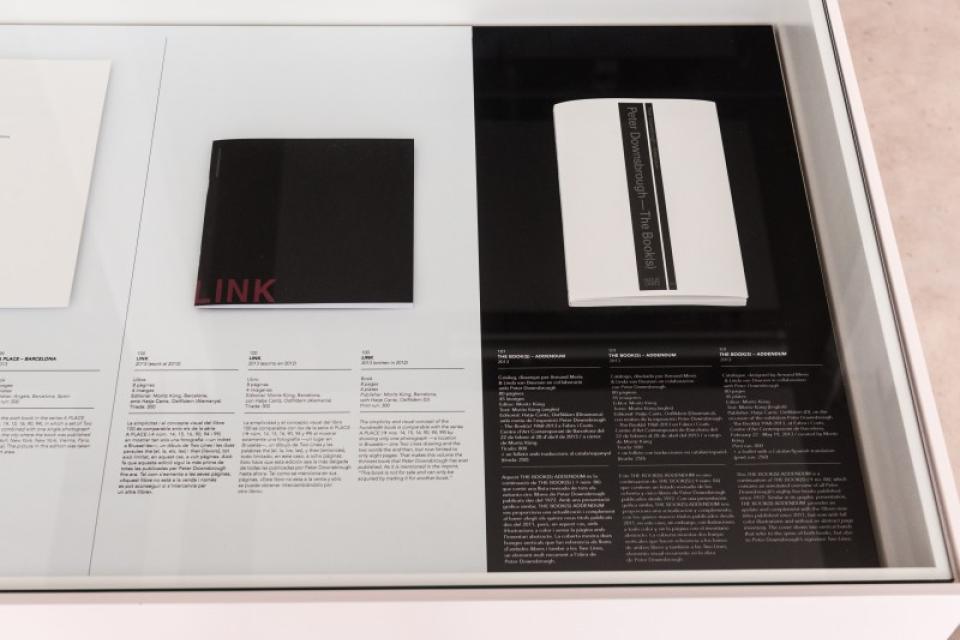Peter Downsbrough The Book(s) 1968-2013
Since 1968, Peter Downsbrough (1940, New Brunswick, N.J., U.S.A., based in Brussels) has made one hundred and one books. For the first time in Barcelona, the exhibition THE BOOK(S) 1968-2013 offers an extensive overview of this impressive component of his oeuvre. Peter Downsbrough belongs to that first generation of artists —including colleagues such as Robert Barry, Sol LeWitt, and Lawrence Weiner in New York; and John Baldessari, Ed Ruscha, and Allan Ruppersberg in California— who use the book as a means for presenting their work. From the beginning he accords the word, and also the book, an objectlike, spatial, if not sculptural, quality. Consequently, one could even consider that he approaches the book as the ultimate exhibition space, one in which he continuously regroups reflections, images, associations, compositions, and proportions. Indeed, Peter Downsbrough refers to the book as a volume, a space within which to work. Generally, the haptic and compositional starting point of his books could come across as quite rigid, sparse, and distant, but looking at the entire group of publications, instead of at a single one, reveals a particular virtuosity and rich interaction with this basic media.
The most frequently appearing formal tools are words —nouns such as altitude, place, line, structure, zone; adjectives such as locative, horizontal, static, vertical; verbs such as locate, post, reset; adverbs such as here, now, up; prepositions such as as, to—, and horizontal or vertical lines, and arrows. Subsequently, he will expand this vocabulary with grids, diagonals, technical plans, cuttings, photographs, punctuation marks, geographical maps, sketches, altered postcards, and film stills, which he will endlessly combine in ever-changing configurations. The exhibition provides a comprehensive overview of this impressive production of books, presenting them in eighteen large showcases with separate copies for browsing and thirty short films shown on monitors. In addition, for this occasion, Peter Downsbrough conceived three new works in relation to the exhibition space.
In contemporary art history there are only a few artists who have dedicated a large part of their output to the continuous and rigorous production of artists books —books that can be considered themselves as art works, not so much by their feel and craftsmanship, but, rather, by how they represent, in an accessible and affordable format, an artistic thought, a position or a stand. Peter Downsbrough has made books throughout his entire career. Indeed, as Downsbrough has repeatedly remarked, he is not making artists’ books, but just books.
However, this modest definition does not cover the reach and depth of his research and commitment: the notion of space within a book. In other words, through the specific approach of the artist, his books become a spatial given, a place and a space in itself. Through the decades, since he wrote his first “script” in 1968, Peter Downsbrough has developed an expanded vocabulary to express and represent a spatiality by means of lines, double lines —his iconic signature work Two Lines—, grids, collages, cut-outs, maps, plans, words —adjectives, verbs, adverbs and prepositions—, photographs, postcards and film stills. With his very first two books, Notes on Location (written in 1968 and published in 1972, as well as in 2012) and Notes on Location II (published in 1973), he laid out the basis for a particularly consistent research, which, in the meantime spans over forty-five years, and focuses mainly on the status of location and on the implication of locating something in relation to space and time. Already, on the first page of the first book, Peter Downsbrough explicitly refers to these parameters by putting first an indication of time (9 a.m.) and place (800’ ASL). In retrospect, this first note can be considered a type of a gauge within his work: that day, in 1968, on which he started writing the manuscript, at nine in the morning, in a place situated 800 feet (about 244 meters) above sea level, a reference to where he was at the time, in his studio, in Etna, New Hampshire.
At the moment, one hundred and one of Peter Downsbrough’s books have been published, including twenty catalogues. The very first catalogue published in 1977 by the Van Abbemuseum in Eindhoven contained, as well, the first list of all his previously published books (no. 12). BOOKS – BÜCHER, published in 1993 by Neues Museum Weserburg, Bremen, was the first publication exclusively dedicated to his production of books (no. 40). The exhibition in 2011 at the deSingel in Antwerp and the publication THE BOOK(S) provided the second attempt to chart, as well as, to comment this remarkable and still growing body of works (no. 86). Last but not least, this exhibition, not only includes all his 100 up-to-date titles, but new site-specific works, and, above all, his latest publication, THE BOOK(S) ADDENDUM, an illustrated update on his fifteen most recent books, that complements to THE BOOK(S). Two Decades, Museum of Modern Art, New York; Artists’ Books, Tate Gallery, London; Reconsidering the Object of Art, MOCA, Los Angeles; Die Schrift des Raumes, Kunsthalle Wien, Vienna; Ecriture, Impressions du Limousin, Centre Georges Pompidou, Paris; Morphing Lights, Floating Shadows, 9th Venice Architecture Biennial, Venice; Artists’ Tower for Peace, Whitney Biennial, New York; Time as Matter, MACBA - Museu d’Art Contemporani de Barcelona; Less is more. Pictures, objects, concepts from the collection and the archives of Herman and Nicole Daled 1966 - 1978, Haus der Kunst, Munich.
Moritz Küng, curator of the exhibition
Peter Downsbrough (b. 1940 / USA, lives in Brussels) studied architecture for a few semesters at the University of Cincinnati, Ohio, and Cooper Union in New York, prior to starting to work as an artist. He had one-person exhibitions at Wide White Space, Antwerp; Van Abbemuseum, Eindhoven; Frankfurter Kunstverein; Le Consortium, Dijon; Palais des Beaux-Arts, Brussels; Muzeum Sztuki, Lodz; FRAC Bourgogne, Dijon or more recently at la BF 15, Lyon and Chelsea Space, London to name a few, and was included in numerous group exhibitions such as documenta 6 - section Artists’ Books, Kassel; Printed Art: a View of Two Decades, Museum of Modern Art, New York; Artists’ Books, Tate Gallery, London; Reconsidering the Object of Art, MOCA, Los Angeles, Die Schrift des Raumes, Kunsthalle Wien, Vienna; Ecriture, Impressions du Limousin, Centre Georges Pompidou, Paris; Morphing Lights, Floating Shadows, 9th Venice Architecture Biennial, Venice; Artists’ Tower for Peace, Whitney Biennial, New York; Time as Matter, MACBA - Museu d’Art Contemporani de Barcelona; Less is more. Pictures, objects, concepts from the collection and the archives of Herman and Nicole Daled 1966 - 1978, Haus der Kunst, Munich.
Peter Downsbrough works with the following galleries: Angels, Barcelona; Martine Aboucaya, Paris; Barbara Krakow Gallery, Boston; Galerie de Multiples, Paris and Galerie Thomas Zander, Cologne.
Moritz Küng (b. 1961 / CH, lives in Barcelona) is an exhibition curator and editor working at the intersection between art and architecture, all over Europe. Most recent projects include institutional solo shows including catalogues with artists like Peter Downsbrough (2011), Dominique Gonzalez-Foerster (2004, 2013), Bas Princen (2011), Ceith Wyn Evans (2009), Heimo Zobernig (2008), and with architects like Christian Kerez (2008), David Kohn (2012), François Roche (2006), SANAA (2008); group shows like The Umbrella Corner, gallery ProjecteSD, Barcelona (2012-13), Jonge Spaanse Kunst, gallery Elisa Platteau, Brussels (2012), The fifth column, Secession, Vienna (2011), 2 1/2 dimensional: Film featuring Architecture, deSingel, Antwerp (2010). He curated twice the Belgian Pavilion at the 54th Art Biennial in Sao Paulo (2002) and at the 11th Architecture Biennial in Venice (2008). He organized recently the international symposium Old School - New Class (on art education) at the Sint-Lucas University Collage in Ghent (2012) and The Age of Less: Nostalgia (on old values and new behaviors) at La Loge, centre of contemporary culture, Brussels (March 2013).





